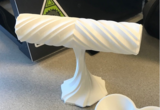
Make a 3D printed bracelet holder using files from Thingiverse, Cura, and a Lulzbot Mini 2 printer
- Subject:
- Engineering
- Material Type:
- Lesson Plan
- Author:
- Alexandra Houff
- Date Added:
- 04/19/2019

Make a 3D printed bracelet holder using files from Thingiverse, Cura, and a Lulzbot Mini 2 printer
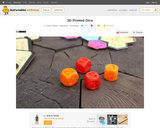
Step by step instructions to print numbered dice for games using a 3D printer and TinkerCad design.
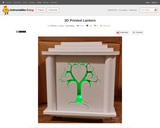
Create a 3D printed lantern in 20 steps.
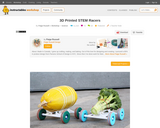
Create 3D printed components for a vegetable/fruit STEM racer!
From the article:
"These 3D printed STEM race cars are the perfect project based learning tool to help teachers get kids excited about science, technology, engineering, math, and nutrition to boot! The racers I show you how to make in this instructable will provide an opportunity to turn almost anything (no kittens or other live things please) into a race car – allowing different sized and weighted objects to illustrate mechanical physics concepts like mass, friction, force, speed, distance, and gravity!"
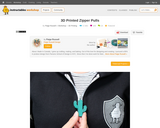
Design and create your own custom, 3D printed zipper pull! This project utilizes Tinkercad and some simple tools.
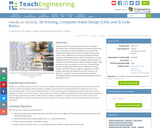
Students learn how 3D printing, also known as additive manufacturing, is revolutionizing the manufacturing process. First, students learn what considerations to make in the engineering design process to print an object with quality and to scale. Students learn the basic principles of how a computer-aided design (CAD) model is converted to a series of data points then turned into a program that operates the 3D printer. The activity takes students through a step-by-step process on how a computer can control a manufacturing process through defined data points. Within this activity, students also learn how to program using basic G-code to create a wireframe 3D shapes that can be read by a 3D printer or computer numerical control (CNC) machine.

These are step by step tutorial handouts for using a Flex Mendel or flexMendel open source 3D printer. There are matching videos located on YouTube at:https://www.youtube.com/playlist?list=PLYZc2FR9EwWYF16SVbPzijWCRbMGpE38uandhttps://www.youtube.com/playlist?list=PLYZc2FR9EwWY7tOr0E_ncfZDYmR3NyQfo

Make cool wall art using a 3D printer. Use themes such as superheroes, space, fantasy, holidays, etc.

This guide takes the reader through the 3D Printing for Repair (3DP4R) process. It consists of guidelines and tools to create a 3D printable version of spare parts needed for a product repair. 3D printing a spare part is more than just printing the original part. Instead, it is an iterative process in which the part is analysed, redesigned, manufactured, and tested, in order to come to a final part. This guide will describe these four phases in detail. The guide is meant for anybody who is interested in trying to manufacture spare parts with 3D printing technologies, remakers, tinkerers, volunteer repairers, professional repairers, and everyone who is interested in repair initiatives.

A Beginner’s Guide for Teachers
Short Description:
This book is for math teachers with little to no experience with 3D printing who would like to incorporate it into their classroom.
Long Description:
This book is for math teachers with little to no experience with 3D printing who would like to incorporate it into their classroom. Included are reasons why 3D printing is useful in a classroom, logistics of how 3D printing works, example activities for all grade levels, and ways for teachers to think of their own activities.
Word Count: 17468
(Note: This resource's metadata has been created automatically as part of a bulk import process by reformatting and/or combining the information that the author initially provided. As a result, there may be errors in formatting.)
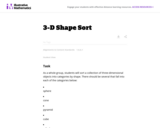
As a whole group, students will sort a collection of three-dimensional objects into categories by shape.

The organic molecules that make up life on Earth are more than just the 2-D structures we’ve been drawing so far. Molecules have 3-D shapes that help us understand what they can do. In this episode of Crash Course Organic Chemistry, we’ll learn how orbital hybridization and valence bond theory can help us explain 3D molecular structures and about constitutional and geometric isomers.

A 2-D map is a great guide here on Earth—and virtually worthless for finding your way around in outer space. Take a 3-D look at mapping our solar system and universe. This Moveable Museum article, available as a printable PDF file, looks at how astronomers use data to create 3-D models of the universe. Explore these concepts further using the recommended resources mentioned in this reading selection.

Using cameras mounted to drones, students will design and construct an experiment to take enough photos to make a 3-dimensional image of an outcrop or landform in a process called structure from motion (SfM). This activity has both a hands-on component (collecting data with the drone) and a computer-based component (creating the 3-dimensional model).___________________Drones can take photos that can be analyzed later. By planning ahead to have enough overlap between photos, you take those individual photos and make a 3-dimensional image!In this activity, you guide the students to identify an outcrop or landform to study later or over repeat visits. They go through the process to plan, conduct, and analyze an investigation to help answer their science question.The Challenge: Design and conduct an experiment to take enough photos to make a 3-dimensional image of an outcrop or landform, then analyze the image and interpret the resulting 3-d image.For instance they might wish to study a hillside that has been changed from a previous forest fire. How is the hillside starting to shift after rainstorms or snows? Monitoring an area over many months can lead to discoveries about how the erosional processes happen and also provide homeowners, park rangers, planners, and others valuable information to take action to stabilize areas to prevent landslides.
(Note: this resource was added to OER Commons as part of a batch upload of over 2,200 records. If you notice an issue with the quality of the metadata, please let us know by using the 'report' button and we will flag it for consideration.)

Children creat a 3 dimensional model of various constellations to learn how 2d images are actually 3d.

Coders use the start on green flag block to create a silly dance party using motion blocks. The purpose of this project is to introduce young coders to adding sprites in code and triggering algorithms with the green flag in ScratchJr.
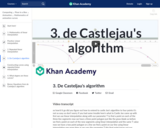
We can use de Casteljau's algorithm to calculate curves using any number of points.

This resource is a video abstract of a research paper created by Research Square on behalf of its authors. It provides a synopsis that's easy to understand, and can be used to introduce the topics it covers to students, researchers, and the general public. The video's transcript is also provided in full, with a portion provided below for preview:
"3D-printed with microscale precision, these tiny architectural marvels could be the key to making high-temperature ceramics less vulnerable to fracture. The implications could span across the numerous areas these materials are used, from aerospace to tissue engineering. The blueprint for these hardy structures is reported in the Journal of Materials Research Volume 33, Issue No. 3, earning honors as the 2018 JMR Paper of the Year. Researchers built the miniature trusses layer by layer using a technique called projection microstereolithography. In this process, a UV-light pattern is scanned across a polymer bath composed of photo-active ceramic building blocks. The silicon-based polymer solidifies at every point traced by the UV beam. Subsequent heating in a high-temperature furnace activates the polymer structures, baking off volatile organics, to produce silicon oxycarbide structures. The team then put these structures to the test..."
The rest of the transcript, along with a link to the research itself, is available on the resource itself.

This resource is a video abstract of a research paper created by Research Square on behalf of its authors. It provides a synopsis that's easy to understand, and can be used to introduce the topics it covers to students, researchers, and the general public. The video's transcript is also provided in full, with a portion provided below for preview:
"When modern 3D printing was invented in the early 1980s, few could have predicted the influence it has today. At no other time in history has it been this easy to transform a sketch into the real thing. And while that feat has proven immensely useful for constructing complex machines, it is unlikely more meaningful anywhere else today than in the field of biomedicine. With the ability to churn out standard or custom prosthetics, devices, and even test models, the 3D printing of biomaterials is revolutionizing medical care. One of the greatest conveniences afforded by biomedical 3D printing is the ability to manufacture parts on demand. Common load-bearing prosthetics, such as those for knee or hip replacements, no longer have to be built in bulk and benched before use. Virtually stored print files can be called upon and processed into parts as soon as they are needed in the clinic, with the printing material and method suited to the part’s function and placement..."
The rest of the transcript, along with a link to the research itself, is available on the resource itself.

Let's take a closer look at the weights used during subdivision. Do we have to be careful when selecting weights?